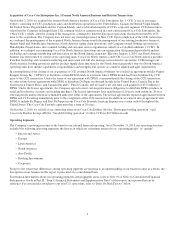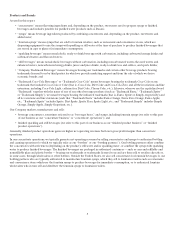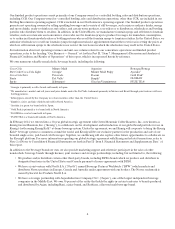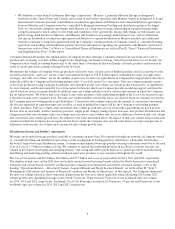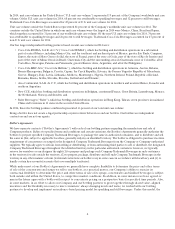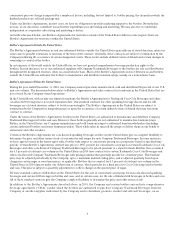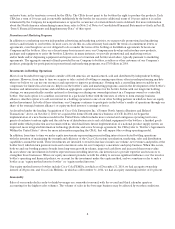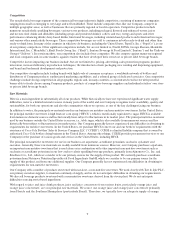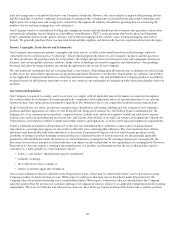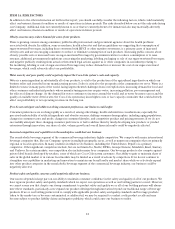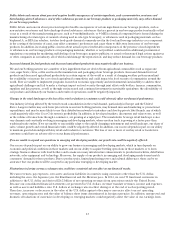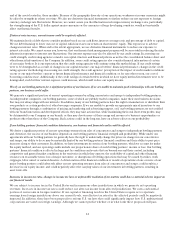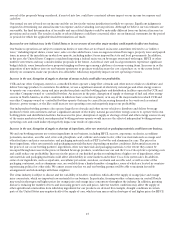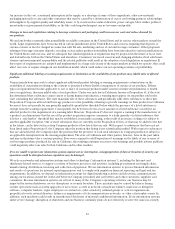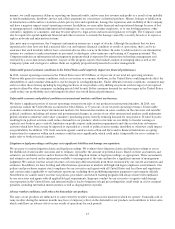Coca Cola 2014 Annual Report Download - page 12
Download and view the complete annual report
Please find page 12 of the 2014 Coca Cola annual report below. You can navigate through the pages in the report by either clicking on the pages listed below, or by using the keyword search tool below to find specific information within the annual report.10
juice and orange juice concentrate that meets our Company’s standards. However, the citrus industry is impacted by greening disease
and the variability of weather conditions. In particular, freezing weather or hurricanes in central Florida may result in shortages and
higher prices for orange juice and orange juice concentrate throughout the industry. In addition, greening disease is reducing the
number of trees and increasing grower costs and prices.
Our Company-owned or consolidated bottling and canning operations and our finished product business also purchase various other
raw materials including, but not limited to, polyethylene terephthalate (“PET”) resin, preforms and bottles; glass and aluminum
bottles; aluminum and steel cans; plastic closures; aseptic fiber packaging; labels; cartons; cases; postmix packaging; and carbon
dioxide. We generally purchase these raw materials from multiple suppliers and historically have not experienced material shortages.
Patents, Copyrights, Trade Secrets and Trademarks
Our Company owns numerous patents, copyrights and trade secrets, as well as substantial know-how and technology, which we
collectively refer to in this report as “technology.” This technology generally relates to our Company’s products and the processes
for their production; the packages used for our products; the design and operation of various processes and equipment used in our
business; and certain quality assurance software. Some of the technology is licensed to suppliers and other parties. Our sparkling
beverage and other beverage formulae are among the important trade secrets of our Company.
We own numerous trademarks that are very important to our business. Depending upon the jurisdiction, trademarks are valid as long
as they are in use and/or their registrations are properly maintained. Pursuant to our Bottler’s Agreements, we authorize our bottlers
to use applicable Company trademarks in connection with their manufacture, sale and distribution of Company products. In addition,
we grant licenses to third parties from time to time to use certain of our trademarks in conjunction with certain merchandise and food
products.
Governmental Regulation
Our Company is required to comply, and it is our policy to comply, with all applicable laws in the numerous countries throughout
the world in which we do business. In many jurisdictions, compliance with competition laws is of special importance to us, and our
operations may come under special scrutiny by competition law authorities due to our competitive position in those jurisdictions.
In the United States, the safety, production, transportation, distribution, advertising, labeling and sale of many of our Company’s
products and their ingredients are subject to the Federal Food, Drug, and Cosmetic Act; the Federal Trade Commission Act; the
Lanham Act; state consumer protection laws; competition laws; federal, state and local workplace health and safety laws; various
federal, state and local environmental protection laws; and various other federal, state and local statutes and regulations. Outside the
United States, our business is subject to numerous similar statutes and regulations, as well as other legal and regulatory requirements.
Under a California law known as Proposition 65, if the state has determined that a substance causes cancer or harms human
reproduction, a warning must appear on any product sold in the state containing that substance. The state maintains lists of these
substances and periodically adds other substances to these lists. Proposition 65 exposes all food and beverage producers to the
possibility of having to provide warnings on their products in California because it does not provide for any generally applicable
quantitative threshold below which the presence of a listed substance is exempt from the warning requirement. Consequently, the
detection of even a trace amount of a listed substance can subject an affected product to the requirement of a warning label. However,
Proposition 65 does not require a warning if the manufacturer of a product can demonstrate that the use of that product exposes
consumers to a daily quantity of a listed substance that is:
• below a “safe harbor” threshold that may be established;
• naturally occurring;
• the result of necessary cooking; or
• subject to another applicable exemption.
One or more substances that are currently on the Proposition 65 lists, or that may be added in the future, can be detected in certain
Company products at low levels that are safe. With respect to substances that have not yet been listed under Proposition 65, the
Company takes the position that listing is not scientifically justified. With respect to substances that are already listed, the Company
takes the position that the presence of each such substance in Company products is subject to an applicable exemption from the warning
requirement. The state of California and other parties, however, have in the past taken and may in the future take a contrary position.




